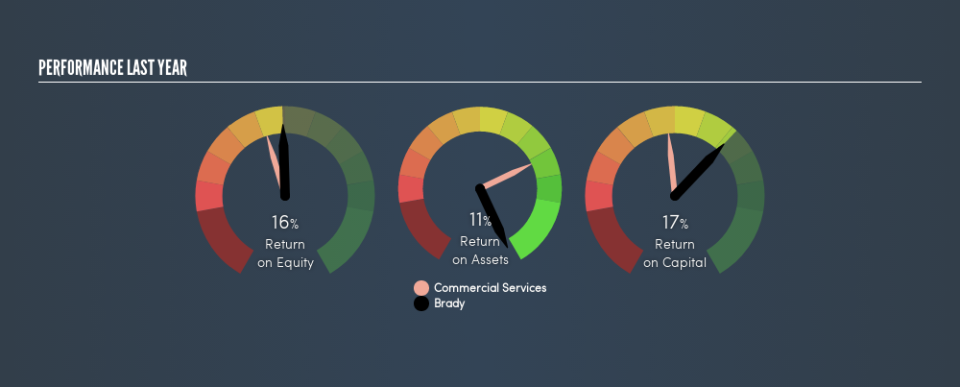Brady Corporation (NYSE:BRC) Is Employing Capital Very Effectively

Want to participate in a short research study? Help shape the future of investing tools and you could win a $250 gift card!
Today we'll evaluate Brady Corporation (NYSE:BRC) to determine whether it could have potential as an investment idea. Specifically, we'll consider its Return On Capital Employed (ROCE), since that will give us an insight into how efficiently the business can generate profits from the capital it requires.
First up, we'll look at what ROCE is and how we calculate it. Next, we'll compare it to others in its industry. Then we'll determine how its current liabilities are affecting its ROCE.
What is Return On Capital Employed (ROCE)?
ROCE is a metric for evaluating how much pre-tax income (in percentage terms) a company earns on the capital invested in its business. In general, businesses with a higher ROCE are usually better quality. In brief, it is a useful tool, but it is not without drawbacks. Renowned investment researcher Michael Mauboussin has suggested that a high ROCE can indicate that 'one dollar invested in the company generates value of more than one dollar'.
So, How Do We Calculate ROCE?
Analysts use this formula to calculate return on capital employed:
Return on Capital Employed = Earnings Before Interest and Tax (EBIT) ÷ (Total Assets - Current Liabilities)
Or for Brady:
0.17 = US$161m ÷ (US$1.1b - US$178m) (Based on the trailing twelve months to April 2019.)
Therefore, Brady has an ROCE of 17%.
Check out our latest analysis for Brady
Is Brady's ROCE Good?
ROCE can be useful when making comparisons, such as between similar companies. Using our data, we find that Brady's ROCE is meaningfully better than the 11% average in the Commercial Services industry. We would consider this a positive, as it suggests it is using capital more effectively than other similar companies. Regardless of where Brady sits next to its industry, its ROCE in absolute terms appears satisfactory, and this company could be worth a closer look.
We can see that , Brady currently has an ROCE of 17% compared to its ROCE 3 years ago, which was 11%. This makes us think about whether the company has been reinvesting shrewdly. The image below shows how Brady's ROCE compares to its industry, and you can click it to see more detail on its past growth.
When considering ROCE, bear in mind that it reflects the past and does not necessarily predict the future. ROCE can be deceptive for cyclical businesses, as returns can look incredible in boom times, and terribly low in downturns. ROCE is, after all, simply a snap shot of a single year. Future performance is what matters, and you can see analyst predictions in our free report on analyst forecasts for the company.
How Brady's Current Liabilities Impact Its ROCE
Liabilities, such as supplier bills and bank overdrafts, are referred to as current liabilities if they need to be paid within 12 months. The ROCE equation subtracts current liabilities from capital employed, so a company with a lot of current liabilities appears to have less capital employed, and a higher ROCE than otherwise. To counteract this, we check if a company has high current liabilities, relative to its total assets.
Brady has total assets of US$1.1b and current liabilities of US$178m. As a result, its current liabilities are equal to approximately 16% of its total assets. A fairly low level of current liabilities is not influencing the ROCE too much.
Our Take On Brady's ROCE
With that in mind, Brady's ROCE appears pretty good. There might be better investments than Brady out there, but you will have to work hard to find them . These promising businesses with rapidly growing earnings might be right up your alley.
If you like to buy stocks alongside management, then you might just love this free list of companies. (Hint: insiders have been buying them).
We aim to bring you long-term focused research analysis driven by fundamental data. Note that our analysis may not factor in the latest price-sensitive company announcements or qualitative material.
If you spot an error that warrants correction, please contact the editor at editorial-team@simplywallst.com. This article by Simply Wall St is general in nature. It does not constitute a recommendation to buy or sell any stock, and does not take account of your objectives, or your financial situation. Simply Wall St has no position in the stocks mentioned. Thank you for reading.

 Yahoo Finance
Yahoo Finance 
